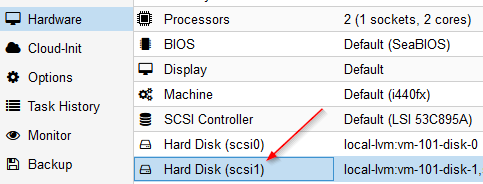To increase the data disk of your nextcloud vm, which is running on proxmox, you need to do the following:
- Make sure no disk snapshot is active or delete them.
- Shutdown VM.
- Check current disk size of your data disk of your nextcloud vm using
lvson your proxmox hypervisor:
root@proxmox1:~#
root@proxmox1:~# lvs
LV VG Attr LSize Pool Origin Data% Meta% Move Log Cpy%Sync Convert
data pve twi-aotz-- <3.49t 0.78 0.28
root pve -wi-ao---- 96.00g
swap pve -wi-ao---- 8.00g
vm-100-disk-0 pve Vwi-a-tz-- 40.00g data 9.99
vm-100-disk-1 pve Vwi-a-tz-- 40.00g data 0.06
vm-101-disk-0 pve Vwi-a-tz-- 40.00g data 58.01
vm-101-disk-1 pve Vwi-a-tz-- 40.00g data 1.60 <-- This is my nextcloud data disk
root@proxmox1:~#
root@proxmox1:~# - In my case this disk is mounted as scsi1 to the VM:

- Increase the disk size using
qm resize <vm-id> <scsi-id> <size>, so for exampleqm resize 101 scsi1 +100Gyour disk:
root@proxmox1:~#
root@proxmox1:~# qm resize 101 scsi1 +3210G
Size of logical volume pve/vm-101-disk-1 changed from 40.00 GiB (10240 extents) to 3.17 TiB (832000 extents).
Logical volume pve/vm-101-disk-1 successfully resized.
root@proxmox1:~#
root@proxmox1:~# lvs
LV VG Attr LSize Pool Origin Data% Meta% Move Log Cpy%Sync Convert
data pve twi-aotz-- <3.49t 0.78 0.28
root pve -wi-ao---- 96.00g
swap pve -wi-ao---- 8.00g
vm-100-disk-0 pve Vwi-a-tz-- 40.00g data 9.99
vm-100-disk-1 pve Vwi-a-tz-- 40.00g data 0.06
vm-101-disk-0 pve Vwi-a-tz-- 40.00g data 58.01
vm-101-disk-1 pve Vwi-a-tz-- 3.17t data 0.02
root@proxmox1:~#
root@proxmox1:~#
- Start your VM.
- Check the zpool size using
zpool list - Check the /mnt/ncdata size using
df -h - Read the new partition size using
parted -lwith the answer "fix" for the adjustment - You can delete the buffer partition 9 using
parted /dev/sdb rm 9 - Extend the first partition using to 100% of the available size
parted /dev/sdb resizepart 1 100% - Use zpool export
zpool export ncdata - Import zpool again
zpool import -d /dev ncdata - Set zpool online
zpool online -e ncdata sdb zpool online -e ncdata /dev/sdbyou can adjust the partition to the correct size- Check the new zpool size using
zpool list - Check the new /mnt/ncdata size using
df -h
Example with nextcloud 20 on Ubuntu 20.04:
root@nextcloud:~#
root@nextcloud:~# zpool list
NAME SIZE ALLOC FREE CKPOINT EXPANDSZ FRAG CAP DEDUP HEALTH ALTROOT
ncdata 39.5G 46.0M 39.5G - 3.13T 0% 0% 1.00x ONLINE -
root@nextcloud:~#
root@nextcloud:~# df -h
Filesystem Size Used Avail Use% Mounted on
udev 3.9G 0 3.9G 0% /dev
tmpfs 797M 1.2M 796M 1% /run
/dev/mapper/ubuntu--vg-ubuntu--lv 39G 5.5G 32G 15% /
tmpfs 3.9G 8.0K 3.9G 1% /dev/shm
tmpfs 5.0M 0 5.0M 0% /run/lock
tmpfs 3.9G 0 3.9G 0% /sys/fs/cgroup
/dev/sda2 976M 198M 712M 22% /boot
/dev/loop0 55M 55M 0 100% /snap/core18/1705
/dev/loop1 56M 56M 0 100% /snap/core18/1932
/dev/loop2 61M 61M 0 100% /snap/core20/634
/dev/loop3 70M 70M 0 100% /snap/lxd/18520
/dev/loop4 62M 62M 0 100% /snap/core20/875
/dev/loop5 72M 72M 0 100% /snap/lxd/18546
/dev/loop6 31M 31M 0 100% /snap/snapd/9721
/dev/loop7 32M 32M 0 100% /snap/snapd/10492
ncdata 39G 19M 39G 1% /mnt/ncdata
tmpfs 797M 0 797M 0% /run/user/1000
root@nextcloud:~#
root@nextcloud:~# parted -l
Model: QEMU QEMU HARDDISK (scsi)
Disk /dev/sda: 42.9GB
Sector size (logical/physical): 512B/512B
Partition Table: gpt
Disk Flags:
Number Start End Size File system Name Flags
1 1049kB 2097kB 1049kB bios_grub
2 2097kB 1076MB 1074MB ext4
3 1076MB 42.9GB 41.9GB
Warning: Not all of the space available to /dev/sdb appears to be used, you can
fix the GPT to use all of the space (an extra 6731857920 blocks) or continue
with the current setting?
Fix/Ignore? Fix
Model: QEMU QEMU HARDDISK (scsi)
Disk /dev/sdb: 3490GB
Sector size (logical/physical): 512B/512B
Partition Table: gpt
Disk Flags:
Number Start End Size File system Name Flags
1 1049kB 42.9GB 42.9GB zfs zfs-4172ff7a9f945112
9 42.9GB 42.9GB 8389kB
Model: Linux device-mapper (linear) (dm)
Disk /dev/mapper/ubuntu--vg-ubuntu--lv: 41.9GB
Sector size (logical/physical): 512B/512B
Partition Table: loop
Disk Flags:
Number Start End Size File system Flags
1 0.00B 41.9GB 41.9GB ext4
root@nextcloud:~#
root@nextcloud:~# parted /dev/sdb rm 9
Information: You may need to update /etc/fstab.
root@nextcloud:~#
root@nextcloud:~# parted /dev/sdb resizepart 1 100%
Information: You may need to update /etc/fstab.
root@nextcloud:~#
root@nextcloud:~# zpool export ncdata
root@nextcloud:~#
root@nextcloud:~# zpool import -d /dev ncdata
root@nextcloud:~#
root@nextcloud:~# zpool online -e ncdata sdb
root@nextcloud:~#
root@nextcloud:~# zpool online -e ncdata /dev/sdb
root@nextcloud:~#
root@nextcloud:~# zpool list
NAME SIZE ALLOC FREE CKPOINT EXPANDSZ FRAG CAP DEDUP HEALTH ALTROOT
ncdata 3.17T 46.1M 3.17T - - 0% 0% 1.00x ONLINE -
root@nextcloud:~#
root@nextcloud:~#
root@nextcloud:~# df -h
Filesystem Size Used Avail Use% Mounted on
udev 3.9G 0 3.9G 0% /dev
tmpfs 797M 1.2M 796M 1% /run
/dev/mapper/ubuntu--vg-ubuntu--lv 39G 5.5G 32G 15% /
tmpfs 3.9G 8.0K 3.9G 1% /dev/shm
tmpfs 5.0M 0 5.0M 0% /run/lock
tmpfs 3.9G 0 3.9G 0% /sys/fs/cgroup
/dev/sda2 976M 198M 712M 22% /boot
/dev/loop0 55M 55M 0 100% /snap/core18/1705
/dev/loop1 56M 56M 0 100% /snap/core18/1932
/dev/loop2 61M 61M 0 100% /snap/core20/634
/dev/loop3 70M 70M 0 100% /snap/lxd/18520
/dev/loop4 62M 62M 0 100% /snap/core20/875
/dev/loop5 72M 72M 0 100% /snap/lxd/18546
/dev/loop6 31M 31M 0 100% /snap/snapd/9721
/dev/loop7 32M 32M 0 100% /snap/snapd/10492
tmpfs 797M 0 797M 0% /run/user/1000
ncdata 3.1T 19M 3.1T 1% /mnt/ncdata
root@nextcloud:~#



